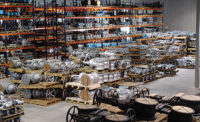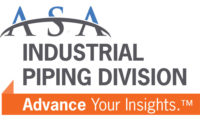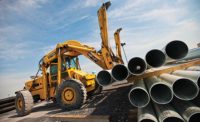Merit Brass Chief Operating Officer Alan Lipp hasn’t seen anything like the current industrial PVF landscape.
“In my 35 years in this business I have never observed times as chaotic as they presently are and there are absolutely no signs that things are settling down,” he says. “In fact, it seems more likely the PVF markets will become even more erratic in the coming weeks and months.”
Lipp cites a number of factors that have led to a frenzied marketplace including the widely discussed Section 232 tariffs, changing dynamics of global supply and demand, extremely volatile raw material prices and the possible imposition of Section 301 as it relates to China. In early July the Trump administration announced a list of 10% tariffs on $200 billion in Chinese goods (including a number of PVF-related products). Those tariffs at the time of the announcement were to undergo a two-month review process.
“We at Merit Brass believe these factors are interwoven,” Lipp says. “The Section 232 tariffs stimulated demand — and in turn price inflation — in the U.S., but there already appeared to be underlying demand based on cyclicality, the impact of regulatory reform and the corporate tax cuts.”
Marketplace trepidation
While industrial PVF manufacturers, distributors and master distributors contacted by Supply House Times are reporting healthy 2018 business performance (see below), almost all see a number of factors on the horizon that give them cause for concern.
One Midwest-based distributor cites the current interest-rate environment, price inflation with the tariffs and the impact on potential new projects, and managing the uncertainty around inventory levels and steel pricing as reasons for pause.
Wolseley Industrial Vice President-Industrial Rob Braig adds: “There are variables associated with product cost that we haven’t seen in recent years such as steel tariffs, lead times and product availability. These variables lead to unpredictability and we’re working hard to make sure we understand the effect of these market conditions.”
Rob Raban, president of master distributor Industrial Valco, says he’s concerned about a potential trade war derailing the world economy “thereby ultimately lowering oil prices due to lowered economic activity,” he says.
Joe Pro, president of manufacturer Penn Machine, already is seeing the effects of the tariffs. “The impositions of the Section 232 tariffs on imported steel and aluminum already are beginning to have an impact,” he says. “Customers already are telling us of delayed or cancelled projects as costs are rising quickly. New higher pricing on affected goods is raising costs on projects as manufacturers simply are unable to absorb 25% tariffs on imported steel. Domestic steel mills already have raised prices and minimum purchase quantities since the tariffs began. A positive ruling by the courts on some of the anti-dumping and countervailing suits will create supply pressures as consumers of foreign PVF products adjust to less supply and higher prices.”
Tariffs aside, several industry executives cited the current labor situation both internally and externally as a current roadblock. “Labor market tightness concerns us,” says Greg Leidner, president and CEO of master distributor United Pipe & Steel. “We are a growing organization and we are having more and more trouble staffing open positions in sales and warehousing operations. Finding great Class A drivers always is a focus for us because our drivers are evangelists to our customer base and the shortage of Class A drivers is a challenge for all industry participants.”
Leidner also notes that in some geographies labor shortages have been mentioned as a reason for projects being postponed. “Longer-term, this can be a positive because it will help ensure a steady pipeline of projects, but short-term, this can negatively impact results,” he adds.
Josh Aberman, executive vice president at Miami-based Lehman Pipe & Plumbing Supply, expresses similar labor-related worry. “Our biggest concern, as I am sure it is with many companies, is finding skilled labor,” he says. “We have multiple positions we need to fill and that we need to be grooming individuals for down the road. We have an incredible industry; however it doesn’t always get the best publicity to help attract new talent.”
Positive gains
While the various headwinds in the industry are swirling, PVF companies throughout the supply chain are seeing financial ledgers with plenty of black ink written in them. “Our business is very brisk for 2018,” says Consumers Pipe & Supply President and CEO Mike Abeling, whose California-based distributorship has opened two new branches and has expanded another. “Volume is good and price increases have added to total revenue increases. Locally commercial construction and MRO work has been on the rise since the elections. Into 2019 we have several projects on the books that will be shipping into next year.”
Jeff Camuso, president of Avon, Massachusetts-based Charles D. Sheehy, says business has been “strong, but always challenging.”
“The market in Boston right now is rich with hotel, condo and apartment development,” adds Camuso, who notes the company has made significant staff additions in recent times that have paid large dividends. “These buildings traditionally have less PVF-intensive systems so we’ve been supplementing our core business with equipment and plumbing-related trim and flow components.”
Kip Miller, president and CEO of Greenville, South Carolina-based Eastern Industrial Supplies and the chairman of the American Supply Association’s Industrial Piping Division, reports his company is projected to be at near double-digit growth when its fiscal year ends in late September. “This can be attributed to same-store sales growth, a new branch opening in Augusta, Georgia, strategic hires, expanded product offerings and an increase in margins,” he says.
Industrial Valco’s Raban notes business has been healthy primarily due to the recovery in oil prices. He’s also excited about the company’s new website that has been in the works for the last two years and will give customers real-time, 24/7 access to its inventory. It’s scheduled for a nationwide rollout in September.
F.W. Webb Senior Vice President of Industrial Business Development Ernie Coutermarsh also reports brisk activity on the industrial side for the Northeast distributor. “As the saying goes, ‘rising tides lift all boats’,” he says. “This robust economy is benefitting Webb’s PVF industrial sales by the obvious opportunities it provides, augmented by our investments and commitment to excel at being a high-performance wholesaler. We are experiencing the predictable benefits of this economic wave and have earned an even larger business share as a result of our logistics excellence and product diversity.”
Coutermarsh adds Webb has benefited from the opening of its state-of-the-art 1-million-square-foot distribution center in New Hampshire.
Looking forward
What does the immediate future hold for the PVF supply chain? “We already have more project work booked for the remainder of 2018 and 2019 than our combined totals for these two critical markets (power and refinery) in 2016 and 2017,” says Brian Tuohey, president of The Collins Companies and the 2018 ASA president.
John Howe, CEO of Birmingham, Alabama-based American Pipe & Supply, adds: “The rest of 2018 and first half of 2019 will be strong. I am concerned about the second half of 2019 and the impact of the tariffs. We have seen multiple price increases from many vendors related to the tariffs. This eventually will have a downstream effect on new projects.”
Matt Chestnut, business development and marketing manager for Houston-based master distributor Merfish Pipe & Supply, says the company’s view is consumption of steel pipe in the second half of 2018 will be similar to the first half, “but hopefully without the intrusion of another non-economic event,” says Chestnut, who notes Merfish is putting the finishing touches on the move of its Northeast warehouse to Delanco, New Jersey.
Merit Brass’ Lipp says some are looking for global oil inventories to decline during the fourth quarter to levels that can push prices back toward or even over $100 per barrel, “which would be extremely bullish for PVF demand and prices,” he says. “Still, the near-term fundamental outlook for industrial metals appears largely linked to the ongoing trade tensions between the Trump administration and China.”
In other words, if you do business in the PVF supply chain, tighten your seatbelts.










